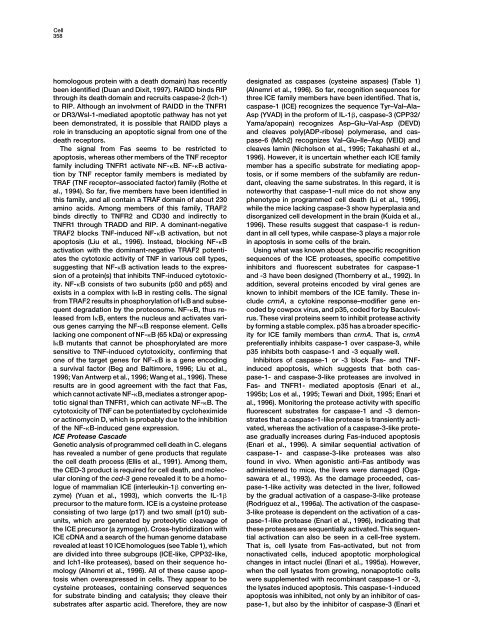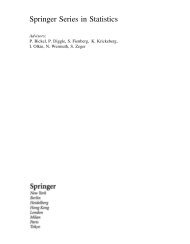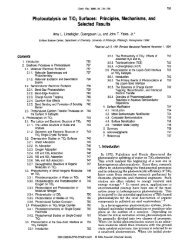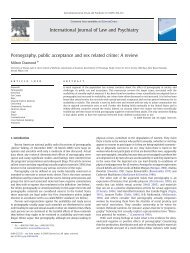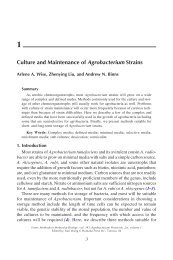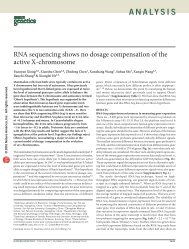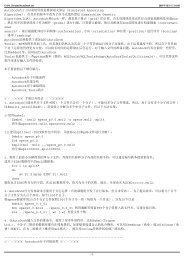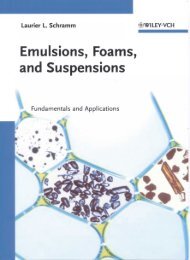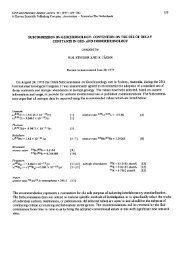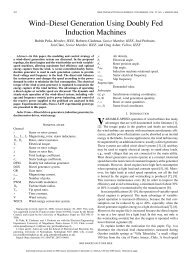Create successful ePaper yourself
Turn your PDF publications into a flip-book with our unique Google optimized e-Paper software.
Cell<br />
358<br />
homologous protein with a death domain) has recently designated as caspases (cysteine aspases) (Table 1)<br />
been identified (Duan and Dixit, 1997). RAIDD binds RIP (Alnemri et al., 1996). So far, recognition sequences for<br />
through its death domain and recruits caspase-2 (Ich-1) three ICE family members have been identified. That is,<br />
to RIP. Although an involvment of RAIDD in the TNFR1 caspase-1 (ICE) recognizes the sequence Tyr–Val–Ala–<br />
or DR3/Wsl-1-mediated apoptotic pathway has not yet Asp (YVAD) in the proform of IL-1�, caspase-3 (CPP32/<br />
been demonstrated, it is possible that RAIDD plays a Yama/apopain) recognizes Asp–Glu–Val-Asp (DEVD)<br />
role in transducing an apoptotic signal from one of the and cleaves poly(ADP-ribose) polymerase, and cas-<br />
death receptors.<br />
pase-6 (Mch2) recognizes Val–Glu–Ile–Asp (VEID) and<br />
The signal from Fas seems to be restricted to cleaves lamin (Nicholson et al., 1995; Takahashi et al.,<br />
apoptosis, whereas other members of the TNF receptor 1996). However, it is uncertain whether each ICE family<br />
family including TNFR1 activate NF-�B. NF-�B activa- member has a specific substrate for mediating apoption<br />
<strong>by</strong> TNF receptor family members is mediated <strong>by</strong> tosis, or if some members of the subfamily are redun-<br />
TRAF (TNF receptor–associated factor) family (Rothe et dant, cleaving the same substrates. In this regard, it is<br />
al., 1994). So far, five members have been identified in noteworthy that caspase-1-null mice do not show any<br />
this family, and all contain a TRAF domain of about 230 phenotype in programmed cell death (Li et al., 1995),<br />
amino acids. Among members of this family, TRAF2 while the mice lacking caspase-3 show hyperplasia and<br />
binds directly to TNFR2 and CD30 and indirectly to disorganized cell development in the brain (Kuida et al.,<br />
TNFR1 through TRADD and RIP. A dominant-negative 1996). These results suggest that caspase-1 is redun-<br />
TRAF2 blocks TNF-induced NF-�B activation, but not dant in all cell types, while caspase-3 plays a major role<br />
apoptosis (Liu et al., 1996). Instead, blocking NF-�B in apoptosis in some cells of the brain.<br />
activation with the dominant-negative TRAF2 potenti- Using what was known about the specific recognition<br />
ates the cytotoxic activity of TNF in various cell types, sequences of the ICE proteases, specific competitive<br />
suggesting that NF-�B activation leads to the expres- inhibitors and fluorescent substrates for caspase-1<br />
sion of a protein(s) that inhibits TNF-induced cytotoxic- and -3 have been designed (Thornberry et al., 1992). In<br />
ity. NF-�B consists of two subunits (p50 and p65) and addition, several proteins encoded <strong>by</strong> viral genes are<br />
exists in a complex with I�B in resting cells. The signal known to inhibit members of the ICE family. These in-<br />
from TRAF2 results in phosphorylation of I�B and subse- clude crmA, a cytokine response–modifier gene enquent<br />
degradation <strong>by</strong> the proteosome. NF-�B, thus recoded <strong>by</strong> cowpox virus, and p35, coded for <strong>by</strong> Baculovileased<br />
from I�B, enters the nucleus and activates vari- rus. These viral proteins seem to inhibit protease activity<br />
ous genes carrying the NF-�B response element. Cells <strong>by</strong> forming a stable complex. p35 has a broader specific-<br />
lacking one component of NF-�B (65 kDa) or expressing ity for ICE family members than crmA. That is, crmA<br />
I�B mutants that cannot be phosphorylated are more preferentially inhibits caspase-1 over caspase-3, while<br />
sensitive to TNF-induced cytotoxicity, confirming that p35 inhibits both caspase-1 and -3 equally well.<br />
one of the target genes for NF-�B is a gene encoding Inhibitors of caspase-1 or -3 block Fas- and TNF-<br />
a survival factor (Beg and Baltimore, 1996; Liu et al., induced apoptosis, which suggests that both cas-<br />
1996; Van Antwerp et al., 1996; Wang et al., 1996). These pase-1- and caspase-3-like proteases are involved in<br />
results are in good agreement with the fact that Fas, Fas- and TNFR1- mediated apoptosis (Enari et al.,<br />
which cannot activate NF-�B, mediates a stronger apop- 1995b; Los et al., 1995; Tewari and Dixit, 1995; Enari et<br />
totic signal than TNFR1, which can activate NF-�B. The al., 1996). Monitoring the protease activity with specific<br />
cytotoxicity of TNF can be potentiated <strong>by</strong> cycloheximide fluorescent substrates for caspase-1 and -3 demon-<br />
or actinomycin D, which is probably due to the inhibition strates that a caspase-1-like protease is transiently actiof<br />
the NF-�B-induced gene expression.<br />
vated, whereas the activation of a caspase-3-like prote-<br />
ICE Protease Cascade ase gradually increases during Fas-induced apoptosis<br />
Genetic analysis of programmed cell death in C. elegans (Enari et al., 1996). A similar sequential activation of<br />
has revealed a number of gene products that regulate caspase-1- and caspase-3-like proteases was also<br />
the cell death process (Ellis et al., 1991). Among them, found in vivo. When agonistic anti-Fas antibody was<br />
the CED-3 product is required for cell death, and molec- administered to mice, the livers were damaged (Ogaular<br />
cloning of the ced-3 gene revealed it to be a homosawara et al., 1993). As the damage proceeded, caslogue<br />
of mammalian ICE (interleukin-1� converting en- pase-1-like activity was detected in the liver, followed<br />
zyme) (Yuan et al., 1993), which converts the IL-1� <strong>by</strong> the gradual activation of a caspase-3-like protease<br />
precursor to the mature form. ICE is a cysteine protease (Rodriguez et al., 1996a). The activation of the caspaseconsisting<br />
of two large (p17) and two small (p10) sub- 3-like protease is dependent on the activation of a casunits,<br />
which are generated <strong>by</strong> proteolytic cleavage of pase-1-like protease (Enari et al., 1996), indicating that<br />
the ICE precursor (a zymogen). Cross-hybridization with these proteases are sequentially activated. This sequen-<br />
ICE cDNA and a search of the human genome database tial activation can also be seen in a cell-free system.<br />
revealed at least 10 ICE homologues (see Table 1), which That is, cell lysate from Fas-activated, but not from<br />
are divided into three subgroups (ICE-like, CPP32-like, nonactivated cells, induced apoptotic morphological<br />
and Ich1-like proteases), based on their sequence ho- changes in intact nuclei (Enari et al., 1995a). However,<br />
mology (Alnemri et al., 1996). All of these cause apop- when the cell lysates from growing, nonapoptotic cells<br />
tosis when overexpressed in cells. They appear to be were supplemented with recombinant caspase-1 or -3,<br />
cysteine proteases, containing conserved sequences the lysates induced apoptosis. This caspase-1-induced<br />
for substrate binding and catalysis; they cleave their apoptosis was inhibited, not only <strong>by</strong> an inhibitor of cas-<br />
substrates after aspartic acid. Therefore, they are now pase-1, but also <strong>by</strong> the inhibitor of caspase-3 (Enari et


